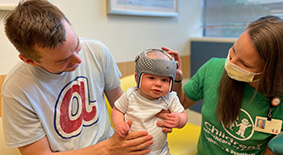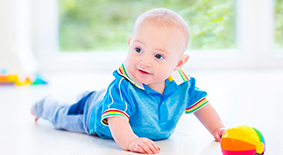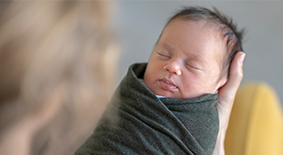Helmet 101: Wear and Care of Your Child’s Cranial Remolding Band
Updated 10/12/21
Some babies have an irregular head shape that may need to be corrected with a cranial remolding helmet or band. Learn how to care for your child during his or her treatment, as well as how to take care of his or her helmet or band so it lasts.
If your infant’s head shape doesn’t correct on its own after trying repositioning exercises at home, we may recommend a baby cranial remolding helmet.
Using 3D images created from a quick head scan at your first appointment, Children’s helmet manufacturer will make a customized helmet to help correct the shape of your child’s head. The helmet is made of half-inch-thick foam and plastic. As your baby grows, our orthotics and prosthetics team will remove layers of this foam to give his or her head more room to grow. This method helps one helmet grow with your child, rather than requiring several helmets along the way.
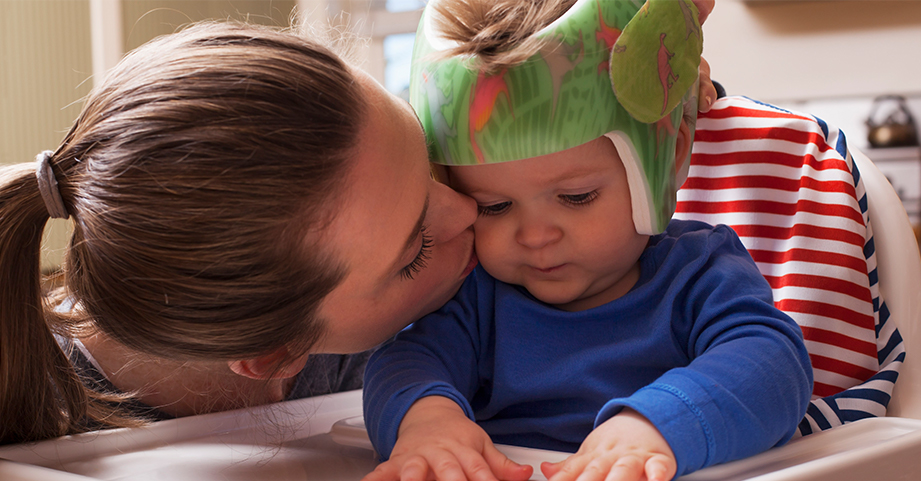
Is helmet therapy painful?
A cranial remolding helmet, also referred to as a band, does not apply pressure to your baby’s head and will not cause pain; the helmet helps create a void for his or her head to grow into. It’s important to bring your child to a specialist if you have concerns about head flatness so your baby’s head has more time to grow with a corrective helmet.
How often will my child have appointments for helmet therapy?
A child comes back to see us every two weeks for adjustments. We will also schedule follow-up scans to monitor your baby’s progress.
How many cranial remolding helmets will my baby need?
At Children’s, we want your baby’s helmet to grow with him or her. With good helmet care, approximately 99% of our patients only need one helmet during treatment. Other cranial remolding companies may require your baby be fitted for and wear multiple helmets to complete treatment. This can be costly.
On average, a child will wear a helmet for three to five months, and babies typically wear their helmet for about 23 hours a day.
However, your baby will follow a special schedule for the first five days he or she wears the helmet. During this break-in period, your baby's skin will adjust to having the helmet against it. You will gradually increase the amount of time he or she wears the helmet, making sure there is no redness or difference in skin texture after wearing the helmet for long periods of time.
Most babies tolerate a helmet well. They are resilient and adapt to wearing a helmet very quickly.
Will the cranial remolding helmet make my baby’s hair fall out?
While this is a common concern, the helmet will not make your baby’s hair fall out. The helmet doesn’t apply pressure to your child’s head, so it should not pull or tug on the hair.
Ideally, your baby should continue sleeping and playing as usual while wearing the helmet, but we know that babies’ routines can be a moving target. These are some common questions parents ask as their child adjusts to wearing a helmet.
Should my baby wear the helmet if he or she is sweating?
It is normal for your baby to sweat for the first two weeks of full-time helmet wear. After two weeks, the sweating should reduce or stop, because your baby’s skin will become used to the helmet. If your baby is sweating, you can take off the helmet, dry his or her head and the helmet, and place it back on the head. You can also remove layers of clothes until your baby can stay cool.
What about wearing the helmet when my baby has a fever?
The helmet does not cause a fever. However, your baby may get a fever from illness or teething. If your baby has a fever, remove the helmet if his or her temperature is higher than 100°F. If your child has not been able to wear the helmet for two days or more due to a fever, your orthotist will instruct you on how to return to full-time wear.
Can my child wear the helmet at the beach or in the swimming pool?
Your child’s helmet should be taken off while playing in the sand or swimming. If your baby wears the helmet while playing outside, it’s important to be mindful of how long your baby is out in the sun with the helmet on, because it could cause a heat rash. Once you come back inside, be sure to clean the helmet to remove any sweat, dirt or sand.
It’s important to keep your baby’s helmet clean and dry so your baby’s skin doesn’t become irritated. It can be helpful to get into a routine of cleaning your baby’s helmet during bath time.
How do I clean my baby’s helmet?
Clean your baby’s helmet daily with clear rubbing alcohol. Other cleaners can irritate your baby’s skin. Using a textured washcloth or toothbrush, scrub the inside of the helmet. You should make sure the helmet is dry and cool before putting it back on your baby’s head – a hair dryer set on “cool” can help speed up the drying process.
When should I clean my baby’s helmet?
You’ll want to clean your child’s helmet if it is visibly dirty or soiled. You’ll also want to clean your child’s helmet if your baby is sweating (this “break-in” period is normal in the first two weeks of wearing it), has been playing outside, or gets wet in the pool, lake or ocean.
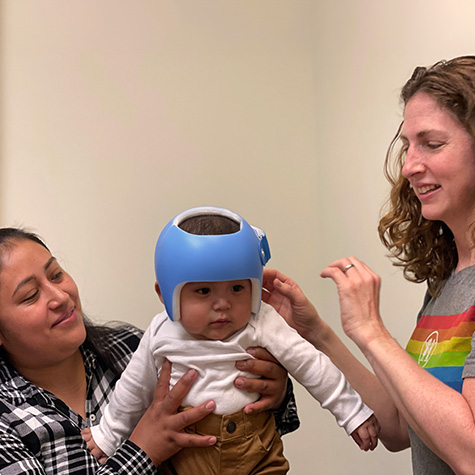
Supporting parents with accessible evaluations
Children's performs evaluations and initial scans for flat head syndrome at no cost, and most insurance plans are accepted. We have seven locations across metro Atlanta for assessment and treatment.
Find a LocationThis content is general information and is not specific medical advice. Always consult with a doctor or healthcare provider if you have any questions or concerns about the health of a child. In case of an urgent concern or emergency, call 911 or go to the nearest emergency department right away. Some physicians and affiliated healthcare professionals on the Children’s Healthcare of Atlanta team are independent providers and are not our employees.
Contact Us 404-785-3229
